#karakasa kozo
Explore tagged Tumblr posts
Text
That was the Fairy Tale Card yokai talking during the fight where Zuma was fully transformed, right? At some points I was questioning whether it was ‘Brella Boy. Does Umbrella Boy speak?
2 notes
·
View notes
Text


LunoTober Day 15: Mythical
Shoutout to karakasa kozō gotta be one of my top 10 yōkai fr 🙏🏽🙏🏽🙏🏽
#lunotober#inktober#drawtober#my art#me art#my artwork#karakasa kozo#karakasa obake#japanese yokai#yokai#japanese mythology#mythical#mythical creatures
4 notes
·
View notes
Text

Listen to our latest episode where we explore the world of yokai!
#supernatural selection#podcast#comedy#folklore#japan#yokai#kappa#akaname#nurikabe#karakasa kozo#bakeneko
5 notes
·
View notes
Text

Every time I see people talking about the Pandemonium Tsukasa card they're like "oh, he's a kitsune!!! He's a tanuki!!!"
Which, like, is true and important and relevant, but I haven't seen anyone point out, very notably,


He's a kasa-obake. Also called karakasa-obake and karakasa kozo, they're classed typically as tsukumogami (tools that have become self aware when they turn 100 years old) (there is debate about this classification but for the sake of it, I'm not getting into it). They only have one eye, which is likely why Tsukasa above has one of his shadowed (besides the usual spooky supernatural hidden motives reasons). Karakasa are usually best known for being tricksters who like to jumpscare and prank people, but are ultimately fairly harmless and just enjoy the attention. They are most notable for being a yokai that isn't attached to any particular legend or folktales; people just started drawing them around the Edo period and they started showing up everywhere, with more people making stories about them. Nowadays they are pretty much a staple yokai for haunted houses, like a bedsheet ghost that will lick you.
(Karakasa also share a lot of similarities to hitotsume-kozo (or One Eyed Brat), they are functionally the same type of ghost but one is just a child.)
I couldn't tell you how relevant this is to his character, or if they just did it for the pun, but I mostly just thought it was unfortunate people didn't seem to realize there was a third, very neat yokai influence in this picture (or just weren't acknowledging it because it's not as a trendy as the other two in English speaking circles)
#project sekai#prsk#tsukasa tenma#i'll leave the character interpretations to the people#who are actually good at it LOL
121 notes
·
View notes
Photo
Love you

Karakasa Kozo from Japanese myth.
3 notes
·
View notes
Photo


Modern hakata belt, with the following youkai pattern: bakeneko (two tails cat), chochin obake (lantern ghost), wanyudo /or/ katawaguruma (flaming wheel), okubi (floating head), karakasa kozo (umbrella ghost).
Those monsters are scattered among humans skulls, maybe as a mekurabe ghost, maybe as a traditional motif named nozarashi (scattered bones in a field) - echoing the skull obidome by Kisai-ya.
#japan#fashion#kimono#obi#youkai#yokai#monster#bakeneko#chochin obake#wanyudo#katawaguruma#okubi#karakasa kozo#mekurabe#nozarashi#Kisai-ya#帯#着物
154 notes
·
View notes
Photo

-Karakasa-obake, sentient umbrella- Also known as a Kasa-obake or a Karakasa kozō, it's a famous yokai from Japanese folklore born from an old chinese-styled paper umbrella that gained sentience. The Karakasa-obake is one of the most famous examples of a tsukumogami. The term had many different meanings across the years, but is today generally understood as a type of yokai, born when an object used by humans reaches its 100th birthday and gains self-awareness. Tsukumogami usually assume a form resembling a monstrous version of the object they used to be. Unlike many yokais, tsukumogami aren't usually malicious or harmful to humans by nature, but can hold some grudge against their previous human owners depending on how well maintained they were in the their "previous life". Karakasa-obake are usually portrayed as ghastly paper umbrellas with a single eye, a long, protruding tongue and either one or two legs which they use to hop around. They don't have any unique ability or are responsible for any sort of supernatural phenomena, but instead just enjoy scaring humans with an unexpected lick... Yikes!
#karakasa#karakasa obake#kasa obake#karakasa kozo#yokai#tsukumogami#japanese folklore#Japanese mythology#japan#monster design#character design#shin megami tensei v#Shin Megami Tensei#persona#persona 5
76 notes
·
View notes
Photo

Walpurgis Sprite 6: Bonnet Karakasa Kozō
A bonnet is like an umbrella, I guess. Gives shade, blocks rain, horrible red eye,

#walpurgis sprite#walpurgisnacht#karakasa kozo#kase obake#yokai#monster#monster design#sprite#pixel art#dlyon
3 notes
·
View notes
Photo

Yokai, by Elena Bansh.
#art#elena bansh#folklore#japan#yokai#daruma#oiwa#karakasa-obake#rokuro-kubi#kappa#oni#hitotsume-kozo#tofu-kozo
118 notes
·
View notes
Photo

Creature #005 Kasa Obake!
#Kasa Obake#Kasa#Obake#art#ghost#005#2017#creature#umberella#Japan#spirit#tsukumogami#kasa bake#karakasa obake#karakasa kozo#demon#folktale#folk#bakemono#Muromachi period#humanoid#object
0 notes
Text
Precure Day 225
Episode: Yes! Precure 5 Go Go! 27 - “Rin-chan VS the Monsters of Edo!” Date watched: 20 September 2022 Original air date: 17 August 2008 Screenshots Precure Metamorphose Gallery | Sky Rose Translate Gallery Project info and master list of posts
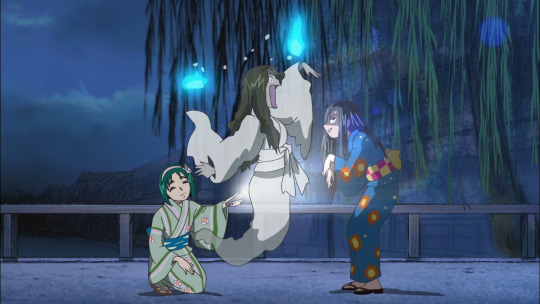
I ain’t afraid of no ghost
It’s summer in French Tokyo, and that means it’s festival time. But what is a festival without a test of courage? And who better to host a test of courage than the girl who’s afraid of ghosts?
Wait…
NOTE: This is an episode really steeped in Japanese culture and traditions, so it may not translate well if you’re not familiar with the ideas. I could write an entire post about the references and stuff, but I’ll just give a brief rundown during the miscellaneous section with some links for further reading.
The Plot
Rin and Komachi are preparing a test of courage. Rin is nervous because she doesn't like monsters.

Shibiretta mocks Anacondy for the invasion of Eternal and the defeat of Nebatakos. She snarkily suggests Anacondy should write a report.
Karen, Urara, Nuts, and Coco are at the festival. Nozomi, Kurumi, and separately Syrup are running late. The former group pairs off to find the others.
Shibiretta casts a spell. Everyone finds themselves in an Edo setting confronting Yokai. All fairies revert to their fairy forms and cling to whoever they're with as they flee from the monsters.
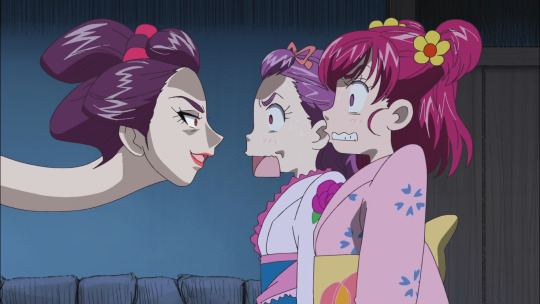
Rin is extra scared but Komachi cheers her on, pointing out that their meeting point is still in sight.
Komachi has a plan to overcome Rin's fear in the process. They manage to scare off a skeleton with masks. Rin scares a ghost by pretending to be another ghost.
Urara & Coco, Karen & Nuts, and Syrup run into Nozomi & Milk. Kurumi points out they agreed to meet at the Torii gates.
RIn and Komachi make it to the torii but find Shibiretta there. She turns an umbrella into a Hoshiina, a karakasa kozo (jumping umbrella). Rin freaks out but they transform.
Mint says they won't give up, Rouge declares she's not scared. She does a combo on the monster.
The other girls arrive, Lemonade and Mint combo to toss the monster around and Rose finishes it with Blizzard. Rouge launches a Fire Strike at Shibiretta. She tries spinning it on her head but it burns her and she disappears.
The girls dress as monsters and scare the boys. Rin is a convincing ghost, and thanks Komachi for helping her overcome her fear, she's very happy. Komachi remarks that the ghost fits her perfectly. The others show up and demand to know if she thinks they fit their characters well, Komachi admits that they were chosen more for comedy.
They chase Komachi and the episode ends.
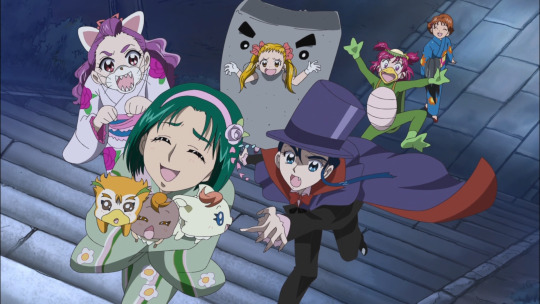
The Analysis
What I Liked
It’s a Rin-centric episode, so that’s an automatic win in my book. Furthermore, it follows up on a plot from last season about Rin’s fear of ghosts and monsters, which I enjoyed.
The various situations the girls found themselves in with the different yokai were great. Even if you could see the gag coming after 2 or 3 attempts, it’s still a worthwhile payoff.

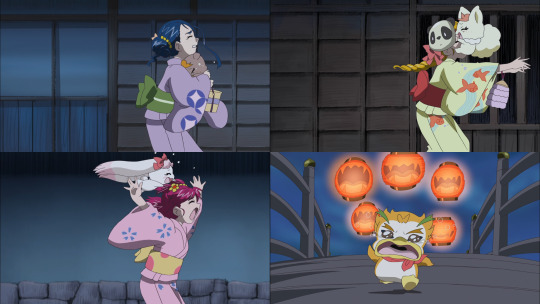

Reverse scaring the yokai is a great spin on the formula and gives some more good gags.
Komachi and Rin are not a common pairing so it’s nice to see them get some focus together.
Rouge overcoming her fear and laying into the Hoshiina is a great sequence.
vimeo
What I didn’t like
I would have liked to see the actual test of courage course, but all we saw were the costumes.
On that note, I wish Rin had been given a full costume as a ghost, rather than just a wig. It’s possible that was a change of plans, given that Komachi had other masks with her.
I wish the girls other than Rin and Komachi had run into more Yokai. Everyone else got one encounter, ran away, and then met up with each other.
The fight with the Hoshiina was a bit odd. The girls ran, then had their triumphant speech, then everyone showed up, and they got beat up some more before pulling through with the winning strategy? You’d expect the speech to signal the turning tide of the battle.
Komachi says that Rin gives her courage, which I don’t think has ever been portrayed, and isn’t well shown in this episode either.
Miscellaneous
A test of courage is a challenge that can take many forms, but usually a group of people go to a scary or haunted destination at night and either take or leave a token to prove they’ve been there. In more staged tests, the path can be lined with props and people dressed as monsters, like a haunted house but outside.
There’s a lot of yokai on display here! Yokai are monsters from Japanese folklore, somewhat analogous to things like Mothman and Sasquatch in North America.
Rin and Komachi first run into what I believe are noppera-bo, the faceless travelers.
Karen and Nuts encounter karakasa kozo, the jumping umbrellas. The Hoshiina is also a giant one of these.
Urara and Coco meet a kijo, a female oni.
Nozomi and Kurumi are frightened by a rokurokubi, a woman with an extending neck.
Syrup is seen running from a group of chochin obake, or living paper lanterns.
Rin and Komachi later encounter a skeleton, which doesn’t seem to be a specific yokai. (The only skeleton yokai I found was a gashadokuro, which is giant)
Rin and Komachi also encounter a yurei, or a Japanese ghost, and that’s exactly what Rin is impersonating as well.
The costumes that Komachi gives to the girls at the end are as follows
Karen is a vampire
Kurumi is a cat
Urara is a nurikabe (a living wall)
Nozomi is a kappa ( a river spirit).

Komachi praises Rin a few times by calling her a Yamato Nadeshiko, which is a complicated term that basically means an ideal Japanese woman. It doesn’t feel apt to me.
Normally, individual transformations are done in roll order (Dream, Rouge, Lemonade, Mint, Aqua, Rose) barring anyone missing. However when Rin and Komachi transform, Komachi’s is shown first.
Milk transforms into her fairy form for the first time since episode 25. Not that long but still.
Conclusion
It’s a fun summer episode, similar to the ghost episode from last season but with a different take on events. I like how the yokai interact with the girls, and I like how the scattered girls manage to find each other once again. It’s super fun, but there’s not much to say beyond that as it's summer filler. I do appreciate that it coincidentally lines up with the spooky season as I’m writing this. Japan likes to do ghosts and spooks in summer as opposed to fall.
Next time, on Precure Daily, the third monarch makes their debut! Look forward to it!
Pink Precure Catchphrase Count: 0 kettei!
10 notes
·
View notes
Photo


Handsome Tengu’s closest buddies are a chochin-obake (lantern yokai) that’s basically a dog, and a karakasa kozo (umbrella yokai) who for some reason sounds like H Jon Benjamin.
3 notes
·
View notes
Text
Monster Month: Kasa-Obake
Kasa-Obake I’ve seen this show up in so many anime that I had to put it on the blog. Doesn’t matter that there isn’t a lot of info out there. The kasa-obake/karakasa-obake/kasa-bake/karakasa kozo . . . It has a lot of names, but it’s always an umbrella creature. Starting to appear during Japan’s Edo period, this is a ghost or yokai, which is a supernatural entity. Not necessarily a demon from…
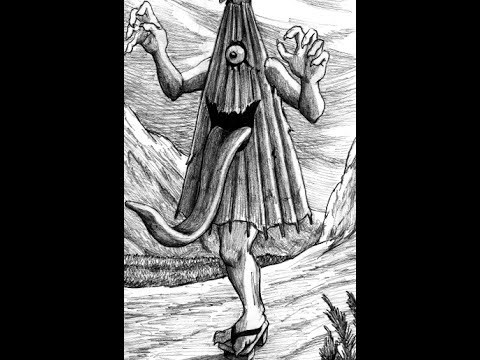
View On WordPress
#creatures#demons#folklore#ghosts#halloween#Japan#kasa-obake#monsters#mythology#october#spooky#umbrella
1 note
·
View note
Photo

Day 3 of my personal drawtober! The word today is Umbrella soooo why not draw a little Karakasa-Kozo?
0 notes
Text
Inspired Encounter: The Hososhi Shrine

image credit: Noblecrumpet
A beggar approaches the players, telling them they were attacked by a red-faced monster with a spear at an abandoned shrine up on the mountain. He's worried that it might come for the village next! The shrine only seems to appear at night, when its lights can be seen from the village.
This is a simple five-part adventure for heroes between levels 2 and 4. The effective CR of the dungeon is 4. The adventure consists of five parts:
Torii Gates - players fight a handful of ghouls known as Jinkininki
Haiden - a puzzle involving bell yokai called Waniguchi
Yokai Ambush - a handful of forgotten objects attack the players
Honden - a Hososhi guardian oni defends against intruders
Kotengu's Ruse - a Kotengu reveals its true reasons for luring the players to the shrine.
Torii Gates
The mountain is treacherous as it has become infested with Jinkininki, yokai that prey on the dead, but the living will do in a pinch. Use the statistics for ghouls as a base but give them resistance to non-magic damage and reduce their hit points to about 15 and give them advantage on Stealth skill checks. The Jinkininki are semi-incorporeal, seeming to fade into their surroundings. The Jinkininki count as undead creatures.
As the players walk along a path of Torii gates towards the shrine, 1d4+1 Jinkininki will stalk the players as they make their way towards the shrine and attack whenever they seem the most vulnerable. Some may even join combat late while the PCs' attention is drawn away.
Haiden
The players can find a fountain at the outskirts of the shrine's grounds. The players can find 5 vials worth of holy water resting in its basin. Stone toro lanterns light the path one by one as players make their way to the shrine proper.
When players reach the Haiden, the main building where worship normally takes place, they find the doors slightly ajar. The paper shoji walls are riddled with holes that are filled with small blinking eyes, noticed by a DC 14 Perception check. These are Mokumokuren yokai. Relatively harmless, but a DC 16 Religion check reveals this to be a sign of a yokai infestation in the shrine.
Inside the Haiden is a room in disrepair. The floorboards are broken, dust coats every inch, and shreds of folded paper lie forgotten on the floor. A chime hanging from the rafters jingles with a light breeze, seeming to repeat the same tune over and over again. An elaborate locked iron gate bars the way towards the shrine's sanctum.
Five brass drum-shaped bells with lie on the floor. They start to shake when the PCs enter. After a few seconds, each sprouts a lizard-like body and opens a toothy maw on the bell's curve. Clanging their bell-mouths together, they attack the trespassing players.
These are Waniguchi yokai, spawned from forgotten drum-shaped temple bells. Each yokai has a symbol on the top of its head (the face of the bell). Ringing the Waniguchi bells in the proper order (with a successful attack roll) will cause the creatures to become dormant and the gate to the shrine to unlock. The order is determined using the symbols, which appear on a wind chime yokai hanging from the roof. It's playing a continual tune which plays in the same order as the Waniguchis. The order is "eye," "sun," "moon," "mountain," "tree." An alternative way to do this puzzle without the symbols is by using props or software; five chimes that each produce a different tone. Players figure out through trial and error which Waniguchi makes which note when hit.
Waniguchi (CR 1/4)
Small Fey, Chaotic Neutral
AC: 14, HP: 60, SPD: 25 ft.
STR 8; CON 14; DEX 16; INT 3; WIS 12; CHA 11
Immunities: psychic, poison
Senses: Darkvision 60 ft., Passive Perception 11
Actions:
Bite: Melee Weapon Attack: +3 to hit, reach 5 ft., one target. Hit: 3 (1d6-1 piercing damage).
Yokai Ambush
Beyond the iron gate is a 40 ft. hallway. Prayers and fortunes written on slips of paper are tacked to the walls, covering the entire upper half of the walls. Trays and basins for offerings are placed on tables on both sides of the hall. Players can find 13 gp worth of coins amongst the offerings, along with a Potion of Healing. At the far end is a closed wooden door. The door is carved with imagery of red flames on a golden field. It is not locked.
When the players reach halfway down the hallway (or if they investigate the offerings, a variety of yokai hidden amongst the offerings attack: A Karakasa Kozo (umbrella yokai), a Jatai (kimono sash yokai), and a pair of Bakezori (sandal yokai). The Bakezori will usually use their action to Help the other yokai once it has tried to Frighten the players.
Karakasa Kozo (CR 2)
Small Fey, Chaotic Neutral
AC: 13, HP: 60, SPD: 20 ft.
STR 6; CON 10; DEX 14; INT 10; WIS 12; CHA 11
Skills: Stealth +4
Immunities: psychic, poison
Senses: Darkvision 60 ft., Passive Perception 11
False Appearance: While not moving, the Karakasa Kozo is indistinguishable from an umbrella.
Actions:
Multiattack: The Karakasa Kozo can make two attacks each round, only one of which can be made with its Lick attack.
Stab: Melee Weapon Attack: +3 to hit, reach 5 ft., one target. Hit: 8 (1d8+3 piercing damage).
Lick: The Karakasa Kozo licks a creature within 5 ft. of it. That creature must make a DC 13 CON saving throw take 7 (2d6) poison damage or become poisoned for 1 minute.
Jatai (CR 1)
Small Fey, Chaotic Neutral
AC: 13, HP: 40, SPD: 30 ft. fly
STR 16; CON 10; DEX 14; INT 10; WIS 12; CHA 11
Skills: Stealth +4
Immunities: psychic, poison
Senses: Darkvision 60 ft., Passive Perception 11
False Appearance: While not moving, the Jatai is indistinguishable from a kimono sash or a strip of loose cloth.
Actions:
Throttle: Melee Weapon Attack: +5 to hit, reach 5 ft., one creature. Hit: 6 (1d6 + 3) bludgeoning damage, and the Jatai attaches to the target. If the target is Medium or smaller and the Jatai has advantage on the attack roll, it attaches by wrapping around the target's head and neck, and the target is also blinded and unable to breathe while the Jatai is attached in this way. While attached to the target, the Jatai can attack no other creature except the target but has advantage on its attack rolls. The Jatai's speed also becomes 0, it can't benefit from any bonus to its speed, and it moves with the target. A creature can detach the Jatai by making a successful DC 13 Strength check as an action. On its turn, the Jatai can detach itself from the target by using 5 feet of movement.
Bakezori (CR 1/8)
Tiny Fey, Chaotic Neutral
AC: 16, HP: 5, SPD: 30 ft.
STR 5; CON 10; DEX 16; INT 10; WIS 12; CHA 11
Skills: Stealth +5
Immunities: psychic, poison
Senses: Darkvision 60 ft., Passive Perception 11
False Appearance: While not moving, the Jatai is indistinguishable from a sandal.
Mobile: The Bakezori can Disengage or Dash as a bonus action.
Actions:
Frighten: The Bakezori chants and chatters maniacally while running about. Creatures within 60 ft. that can hear the Bakezori must make a DC 13 WIS saving throw or become frightened of it for 1 minute. A frightened creature can repeat this saving throw at the end of each of their turns, ending the effect on a successful save. Creatures that succeed at this saving throw are immune to this ability for 24 hours.
Bite: Melee Weapon Attack: +5 to hit, reach 5 ft., one creature. Hit: 1 piercing damage.
Honden
On the other side of the wooden door is the main sanctum of the shrine, the Honden. This room is smaller than the Haiden and contained an ancient statue of a spirit/god/kami the shrine is dedicated to (this can be left up to you based on your campaign). There is a Komainu lion-dog statue in each corner of this room. When the players pass between them, their eyes glow red and a mist starts to manifest in the Honden. A yokai of human shape called a Hososhi appears. It has four eyes that can look in all four directions and a hideous red demonic face capped with two horns and white hair. It wields a spear and shield.
Unbeknownst to the players, the Hososhi is actually protecting the shrine from trespassers that seek the cleric's corpse, and it mistakes the players as a threat. Although it does not speak, it can be reasoned with and understands Common.
Hososhi CR 4:
Medium Fiend, Neutral
AC: 16, HP: 80, SPD: 30 ft
STR 18; CON 13; DEX 12; INT 10; WIS 14; CHA 14
Skills: Perception +6, Intimidation +4, Insight +3
Senses: True Sight 60 ft., Passive Perception 14
Languages: Common
All-Around Vision: The Hososhi can see in all directions at once; it cannot be surprised.
Actions:
Multiattack: The Hososhi can make two attacks each round.
Glaive: Melee Weapon Attack: +5 to hit, reach 5 ft., one target. Hit: (2d8+4 slashing damage)
Volley (recharge 5-6): Ranged Weapon Attack: +5 to hit, range 30 ft., four targets. Hit: (1d6+4 piercing damage). The Hososhi commands its guardian idols to fire a volley of arrows at up to four targets within range. It can choose to attack the same target multiple times.
Reactions:
Parry: The Hososhi can use its reaction to give itself +2 AC against an incoming attack. It can use this ability after the attack has been rolled but before it has dealt damage.
Kotengu's Ruse
After overcoming the Hososhi, a Kotengu arrives through a hole in the roof of the shrine. The Kotengu looks like a humanoid with a crow's head wearing yamabushi robes. It reveals itself as the beggar from the beginning of the adventure in disguise.
The Kotengu tricked the players into coming to the shrine to defeat the Hososhi so that it could take the relics hidden in the shrine. Magical wards kept the Kotengu from entering the Honden, but a mortal entering the Honden broke that seal.
It was hoping for the Hososhi to finish off the PCs, but it has no qualms finishing the job itself. If the Hososhi has aligned itself with the PCs, the Kotengu will be more conservative and attack from the air.
Kotengu (CR 6)
Medium Fey, Chaotic Evil
AC: 15, HP: 100, SPD: 30 ft, 40 ft fly
STR 13; CON 14; DEX 16; INT 13; WIS 12; CHA 16
Skills: Deception +6, Stealth +6
Senses: Darkvision 60 ft., Passive Perception 11
Languages: Common
Hoarder of Magic: Kotengus tend to collect magic items. Roll for a random magic item on Table B, C, or D in the Dungeon Master's Guide in addition to any treasure found on the Kotengu's person.
Actions:
Multiattack: The Kotengu can make two attacks with its rapier or replace one of its two attacks with a use of its Wand.
+1 Rapier: Melee Weapon Attack: +7 to hit, reach 5 ft., one target. Hit: 7 (1d6+4 slashing damage) plus 4 (1d6 lightning damage)
Wand of Magic Missiles: The Kotengu can cast Magic Missile, firing up to three missiles that deal 1d4+1 force damage at three targets. The same creature can be hit by multiple missiles. The Wand has 7 charges which replenish at dawn.
Spellcasting: The Kotengu casts spells as a 5th level spellcaster. It has a +3 spell attack modifier and the saving throw DC for its spells is 14.
At will: Minor Illusion, Mage Hand, Vicious Mockery, Shocking Grasp
1st (4 slots): Detect Magic, Disguise Self, Grease, Speak with Animals
2nd (3 slots): Misty Step, Hold Person, Gust of Wind, Darkness
3rd (2 slots): Wind Wall, Lightning Bolt, Fear
#Inspired Encounter#Yokai#D&D 5e#five room dungeon#Dungeons and Dragons#Noblecrumpet#Dorkvision#Tengu#Oni#homebrew#monster
308 notes
·
View notes
Photo






Yokai (monsters) themed objime by Kisaiya, part of the artist shop at Maison de Neko. Their current themed is “hyakki yagyo” (”night parade of one hundred demons”). From top to bottom, left to right can see here:
Nozarashi (weather beaten bones, those can become mekurabe or gashadokuro yokai)
Kyuubi no kitsune (nine tailed fox)
Rokurokubi (long neck woman)
Nekomata (two tailed cat)
Karakasa kozo (living paper umbrella)
Hitotsume kozo (one-eye priest boy)
#japan#fashion#kimono#obijime#kisaiya#yokai#monster#youkai#Nozarashi#weather beaten#weather beaten skull#bones#mekurabe#gashadokuro#Kyuubi#kitsune#fox#nine tailed fox#Rokurokubi#Nekomata#cat#neko#Karakasa#Karakasa kozo#Hitotsume#Hitotsume kozo#paper umbrella#one-eye priest boy#着物#hyakki yagyo
586 notes
·
View notes